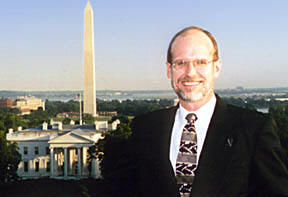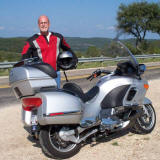|
 Pat Rawlings, was born in
Greenville TX. Pat creates images based on scientific and
technical themes that appeal to both rocket scientists and
regular folk. His extraterrestrial "snapshots" of future
events give viewers a sense of "being there" as explorers
hop from one world to the next using the best technology of
the 21st century. Rawlings' desire to travel in space and
time motivate him to make scenes as accurate as possible.
After consulting with numerous space experts around the
country, he uses hand-built and computer models,
topographical maps, and space and family vacation photos to
mentally create his worlds". "Space art", says the artist,
"provides me with an excuse to talk to some of the most
interesting people in the country, build minature models of
space ships, and then sit in my studio painting or working
on the computer for hours while listening to movie
soundtracks and classical music"
Pat Rawlings, was born in
Greenville TX. Pat creates images based on scientific and
technical themes that appeal to both rocket scientists and
regular folk. His extraterrestrial "snapshots" of future
events give viewers a sense of "being there" as explorers
hop from one world to the next using the best technology of
the 21st century. Rawlings' desire to travel in space and
time motivate him to make scenes as accurate as possible.
After consulting with numerous space experts around the
country, he uses hand-built and computer models,
topographical maps, and space and family vacation photos to
mentally create his worlds". "Space art", says the artist,
"provides me with an excuse to talk to some of the most
interesting people in the country, build minature models of
space ships, and then sit in my studio painting or working
on the computer for hours while listening to movie
soundtracks and classical music"
 Thorough research is the most important element in
Rawlings approach to a space image. Often when discussing a
future mission with an engineer or scientist, he will
discover some unusual point-of-view or quirky detail that
will provide the art with an uncanny realism. For example,
while discussing the Mars Pathfinder landing sequence with a
project engineer at the Jet Propulsion Laboratory, the
artist realized that the mission was landing at night. This
detail, not described in any of the routinely distributed PR
material, completely altered the picture's composition.
Instead of using the sun as a light source, Rawlings
illuminated the landscape with three solid rocket engines in
the aeroshell that fire just as the airbag covered lander is
released. Thorough research is the most important element in
Rawlings approach to a space image. Often when discussing a
future mission with an engineer or scientist, he will
discover some unusual point-of-view or quirky detail that
will provide the art with an uncanny realism. For example,
while discussing the Mars Pathfinder landing sequence with a
project engineer at the Jet Propulsion Laboratory, the
artist realized that the mission was landing at night. This
detail, not described in any of the routinely distributed PR
material, completely altered the picture's composition.
Instead of using the sun as a light source, Rawlings
illuminated the landscape with three solid rocket engines in
the aeroshell that fire just as the airbag covered lander is
released.
After completly understanding the part of the mission
being depicted, Rawlings then develops models of the
elements in the scene. Some of these geometrically precise
models are created from foamcore or plastic, while others
are constructed using modeling software on the artist's
powerful G3 Macintosh. The spacecraft models are based on
engineering drawings produced by the artist or provided by
the client. The setting models are usually based on US
Geological Survey topographical maps and/or orbital
photography.
Pat was formerly the exhibits designer at Johnson Space
Center in Houston. He has been doing NASA art for 17 years,
and works are often seen in a huge number of publications,
but are most often only credited "courtesy NASA"
|